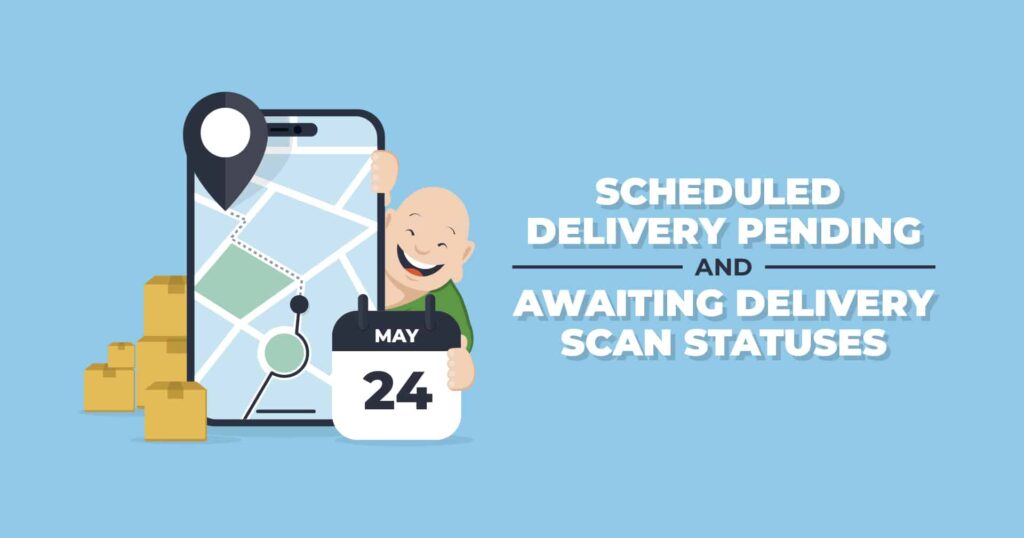When you think about eCommerce order fulfillment, from checkout to delivery, there are about a million things that have to happen perfectly to ensure an order is fulfilled accurately and received on time. Usually that complex system works. Millions of orders are delivered every day, seamlessly meeting customer expectations.
Ecommerce fulfillment companies and shipping carriers work hard to avoid delays because their reputations are built on accurate, on-time delivery. Take ShipMonk, for example. As an eCommerce fulfillment company, our goal is 100% accuracy. No mistakes, ever. At 99.97% accuracy, we’re close. Still, hard as we try, some things are outside of our control.
Weather, customs holdups, and supply chain issues are just a few of the reasons why a package might be delayed on the way to your customers’ doors. When that happens, they may see a message, such as “Scheduled Delivery Pending” or “Awaiting Delivery Scan,” in the shipping carrier’s tracking system and contact you for an explanation. Do you, as the shipper, understand what these terms mean? If not, we’re here to help! Next time a customer calls to find out why their package is delayed you’ll have the answer.
How eCommerce Order Tracking Works
When a 3PL or fulfillment center ships out an eCommerce order, they select the most efficient route and carrier to get the package delivered on time. ShipMonk, for example, has their own proprietary software platform for routing packages most economically. Once the carrier is selected, they print a shipping label according to that particular carrier’s specifications.
The shipping label gives the package a unique barcode and tracking number. The barcode is scanned every time the package is moved: when it leaves the fulfillment center on the carrier’s truck, when it arrives at the carrier’s processing facility, when it leaves the carrier’s processing facility, when it arrives at or leaves another processing facility, when it’s out for delivery, and when it arrives at the customer’s door.
Each shipping carrier has its own methodology for creating tracking numbers and a software platform that updates the package’s status each time the label is scanned. In this way, all four parties involved (the carrier, the eCommerce seller, the fulfillment company, and the end-customer) all have access to this tracking information and can opt-in to receive updates.
Just as customers can opt-in to receive text updates about a delivery, the eCommerce seller can receive automated notifications when a package is delayed—provided their 3PL has enabled software integrations between the carrier and their order management system. That way, when a customer service request comes in, the eCommerce business has full visibility into the order status and can explain what it means, or step in to troubleshoot problems with the carrier if necessary.
Delivery Statuses and Their Meanings
In Transit means your package is “en route” on a plane, train, ship, or truck. Its status won’t change until it arrives at its next location and is scanned.
Scheduled Delivery Pending means that for reasons outside of their control, the carrier can no longer meet the expected delivery date, and does not yet have a new date to give you. You might see this message during peak shopping season when the volume of packages exceeds the carrier’s capacity, or when a natural disaster or weather event severely impacts travel. The important thing to note is that they have your package and it will be delivered, but the exact date is pending.
Out for Delivery means your postal carrier or local FedEx or UPS driver has the package on their truck—or at least is supposed to have it on their truck. See “awaiting delivery scan” for exceptions.
Awaiting Delivery Scan means the package was out for delivery, but has not yet been scanned at the door. This doesn’t necessarily mean the package wasn’t delivered—sometimes the mail carrier simply forgets to scan the package, or the system hasn’t yet updated its status. Unfortunately, it might also mean the carrier didn’t see the package, ran out of time, or there wasn’t enough room on the truck. This status is usually resolved by waiting a day or two.
Delivery Exception indicates that for some reason the package could not be delivered as planned. There are several reasons you might see a delivery exception. A snowstorm or truck breakdown may cause a short delay, in which case a new delivery date will be scheduled. Perhaps the package required a signature and there was no one home to sign for it, or a guard dog prevented the carrier from reaching the door. While unfortunate, these causes could not have been foreseen or prevented by the shipping company. Other delivery exceptions may be the shipping carrier’s fault, such as a label that was damaged in transit, or a lost or damaged package. In these instances, the carrier’s insurance usually covers the cost to replace and resend the package.
More problematic for the eCommerce seller are those issues that could have been prevented, such as an incorrect address, a missing or incorrect label, missing paperwork or an incorrect tariff code for an international shipment. Sometimes a 3PL might even forget to contact the shipping carrier for a pickup. A tech-forward 3PL like ShipMonk would have verified the address, paperwork and codes before shipping, and automated the shipping request to prevent such errors.
Exception: Action Required UPS uses this language on notifications to flag Delivery Exceptions that need your attention before the package can move further. Most often, the action involves verifying an address due to a damaged label, or correcting an incorrect address. In these cases, the eCommerce company’s customer service department may have to contact the end-customer.
Delivery Not Attempted is the message you’ll see when a package was out for delivery, but something prevented the driver from delivering it. They may simply have run out of time in the day, or they physically could not get there due to unplowed or flooded streets.
How to Help a Customer with a Delayed Delivery
Unfortunately, when a package is not delivered on time, the eCommerce seller often gets blamed, even though a delayed delivery is rarely their fault. The best way to maintain a good relationship with your customer is to be proactive. Reach out to the carrier as soon as you see a problem, and then reach out to the customer.
There may not be much you can do, especially if the carrier is already doing their best, but at least you can let the customer know the cause of the problem (if the carrier has details) and that others are being impacted as well. If the delay continues, you always have the option of reshipping the order.
Your Package Has Been Delivered
Remember, in most cases packages are delivered accurately and on time. When delays do occur, it’s important for eCommerce sellers to know the lingo. If you understand the tracking terminology, you can notify the impacted customers and advocate for those customers with the shipping company when necessary. Ultimately your goal is the tracking status we all love to see, “Your package has been delivered.”
If you’re seeing too many problems with eCommerce shipments, such as incorrect addresses, inaccurate orders, or orders that aren’t shipped out on time, a change in fulfillment companies might be the answer. Contact ShipMonk today for a quote or software demo that will change your status for the better.





